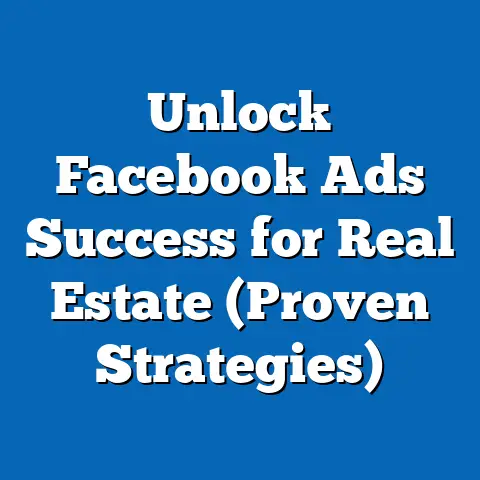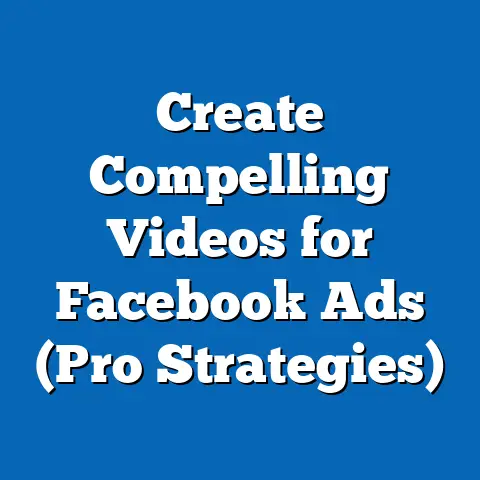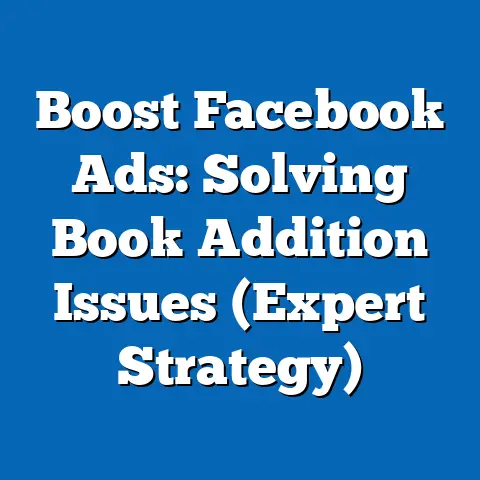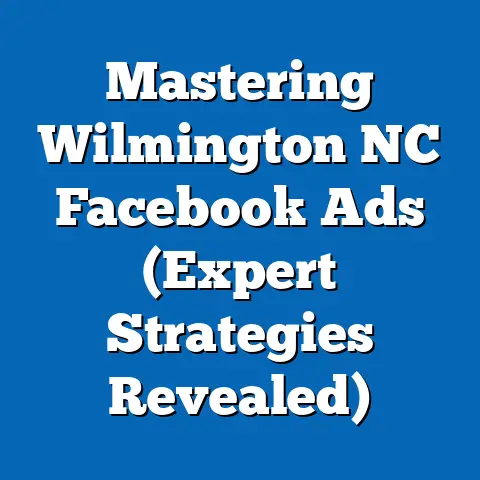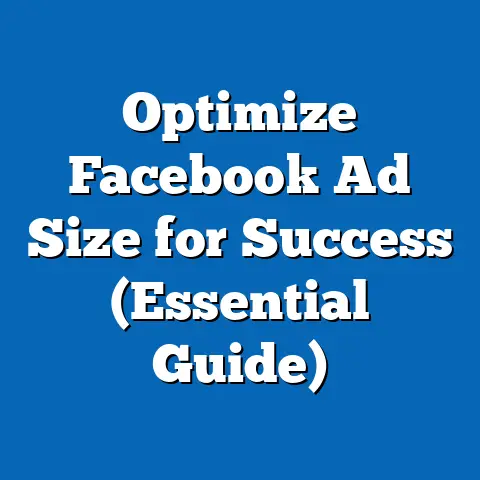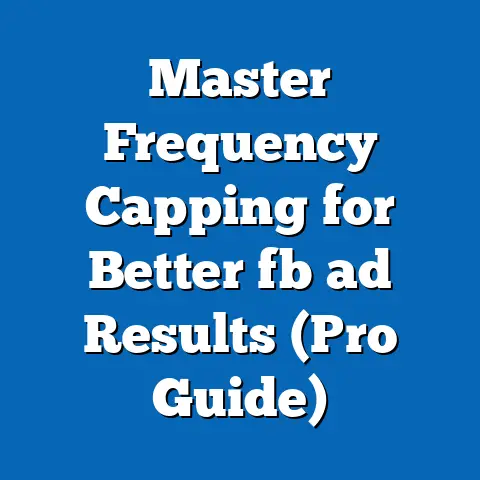Unleash Winning Facebook Ads (Expert Strategies Revealed)
Have you ever watched a superhero team like The Avengers come together, each member contributing their unique skills to achieve a common goal? That’s how I see successful Facebook advertising campaigns. Each element – the targeting, the creative, the copy, the budget – needs to work in harmony to achieve extraordinary results. Just like Iron Man’s tech-savvy or Captain America’s strategic leadership, a winning Facebook ad strategy requires a blend of technical know-how and insightful planning.
In today’s digital battlefield, Facebook ads are your Avengers-level weapon. With over 2.9 billion monthly active users (Meta Q1 2024 Earning Results), Facebook remains a powerhouse for businesses looking to connect with their target audience. But simply throwing money at the platform won’t guarantee success. According to Statista, global digital ad spending is projected to reach nearly $627 billion in 2024, highlighting the increasing competition for attention. Therefore, understanding and implementing expert strategies is crucial to stand out and maximize your return on investment.
This article isn’t just another surface-level guide. I’m going to pull back the curtain and reveal the strategies I’ve used to help businesses of all sizes achieve remarkable results with Facebook ads. From understanding the platform’s ever-evolving ecosystem to crafting compelling ad creatives and mastering advanced targeting techniques, I’ll equip you with the knowledge and tools you need to unleash winning Facebook ads.
Section 1: Understanding the Facebook Advertising Ecosystem
The world of Facebook advertising is constantly changing. What worked yesterday might not work today. To truly master it, you need to understand its evolution, the different ad types available, and the central hub that controls it all: the Facebook Ads Manager.
The Evolution of Facebook Ads
I remember when Facebook ads first started. They were simple banner ads, barely noticeable amidst the clutter of status updates and FarmVille requests. Over the years, Facebook has transformed its advertising platform into a sophisticated, data-driven machine.
Key milestones include:
- The introduction of News Feed ads: This was a game-changer, allowing ads to seamlessly integrate into the user’s browsing experience.
- The launch of the Facebook Pixel: This tracking tool revolutionized retargeting, enabling businesses to reach users who had already interacted with their website.
- The expansion of targeting options: Facebook’s granular targeting capabilities, based on demographics, interests, behaviors, and more, allowed advertisers to reach highly specific audiences.
- The rise of video ads: As video consumption exploded, Facebook adapted by prioritizing video content and offering a variety of video ad formats.
Facebook’s ad policies and algorithms have also undergone significant changes. The platform is constantly tweaking its algorithm to improve user experience, which can impact ad reach and performance. Staying informed about these changes is essential to adapt your strategies and maintain a competitive edge. I always recommend subscribing to Facebook’s official blog and following industry experts to stay on top of the latest updates.
Types of Facebook Ads and Their Unique Advantages
Facebook offers a diverse range of ad formats to suit different business goals and target audiences. Here’s a breakdown of some of the most popular options:
- Image Ads: These are the simplest ad format, featuring a single image and accompanying text. They’re great for showcasing products, announcing promotions, or driving traffic to your website. I’ve found that high-quality, visually appealing images are crucial for capturing attention in the crowded News Feed.
- Video Ads: Video ads are highly engaging and can effectively convey complex messages. They’re ideal for brand storytelling, product demonstrations, and capturing attention. Facebook offers various video ad formats, including in-feed videos, Stories ads, and Reels ads. I have personally seen video ads outperform image ads, especially when they tell a compelling story.
- Carousel Ads: Carousel ads allow you to showcase multiple images or videos in a single ad unit. This format is perfect for highlighting different features of a product, telling a story in sequence, or promoting multiple products at once. I’ve used carousel ads to showcase different angles of a product, highlighting key features and benefits.
- Slideshow Ads: Slideshow ads are a cost-effective alternative to video ads. They combine a series of images with music or text to create a visually appealing experience. I’ve used slideshow ads to create simple yet engaging product demonstrations.
- Collection Ads: Collection ads are designed for e-commerce businesses. They feature a cover image or video followed by a selection of related products. This format allows users to browse and purchase products directly from the ad. I find collection ads to be extremely effective for driving sales, especially when targeting users who have previously shown interest in similar products.
- Lead Ads: Lead ads are designed to generate leads directly on Facebook. They feature a form that users can fill out without leaving the platform. This format is ideal for collecting contact information, gathering feedback, or offering free resources. I’ve seen lead ads work wonders for businesses offering free consultations or downloadable guides.
Each ad type has its unique advantages, and the best choice depends on your specific goals and target audience. I always recommend testing different ad formats to see what resonates best with your audience.
The Facebook Ads Manager: Your Control Center
The Facebook Ads Manager is the central hub for creating, managing, and analyzing your Facebook ad campaigns. It’s a powerful tool that provides access to a wide range of features and functionalities.
Key features of the Ads Manager include:
- Campaign Creation: The Ads Manager guides you through the process of creating new campaigns, setting your objectives, defining your target audience, and choosing your ad placements.
- Ad Set Management: Ad sets allow you to group your ads based on specific targeting criteria, budgets, and schedules. This allows you to test different targeting options and optimize your campaigns for maximum performance.
- Ad Creation: The Ads Manager provides a user-friendly interface for creating your ad creatives, including images, videos, and text.
- Reporting and Analytics: The Ads Manager provides detailed reports on your ad performance, including metrics such as impressions, clicks, conversions, and cost per acquisition.
Navigating the Ads Manager can be overwhelming at first, but with practice, it becomes an indispensable tool for managing your Facebook ad campaigns. I recommend exploring the different features and functionalities to familiarize yourself with the platform.
Knowing Your Audience: The Key to Effective Targeting
One of the biggest advantages of Facebook advertising is its granular targeting capabilities. You can target users based on a wide range of factors, including:
- Demographics: Age, gender, location, education, job title, and more.
- Interests: Hobbies, passions, and topics they follow on Facebook.
- Behaviors: Purchase history, online activity, and device usage.
- Custom Audiences: Lists of existing customers or website visitors that you upload to Facebook.
- Lookalike Audiences: Audiences that share similar characteristics to your existing customers.
Understanding your target audience is crucial for creating effective ad campaigns. I always start by conducting thorough audience research to identify their demographics, interests, pain points, and motivations. This information will help you craft compelling ad creatives and target the right users with the right message.
Takeaway: Understanding the Facebook advertising ecosystem, including its evolution, ad types, the Ads Manager, and audience targeting, is essential for creating successful campaigns.
Section 2: Crafting the Perfect Ad
Even with the most precise targeting, your ads will fall flat if they don’t capture attention and resonate with your audience. Crafting the perfect ad involves creating compelling visuals, writing engaging copy, and including a strong call to action.
Compelling Visuals: Grabbing Attention in the News Feed
In the fast-paced world of social media, visuals are king. Your ad’s image or video is the first thing users will see, so it needs to be eye-catching and relevant to your target audience.
Here are some tips for designing effective visuals:
- Use high-quality images and videos: Blurry or pixelated visuals will instantly turn users off. Invest in professional photography or videography, or use high-quality stock images.
- Choose visuals that are relevant to your target audience: Consider their demographics, interests, and cultural background.
- Use bright colors and bold designs: Stand out from the clutter of the News Feed with visually striking visuals.
- Showcase your product in action: Demonstrate how your product solves a problem or improves the user’s life.
- Use text overlays sparingly: Too much text can make your visuals look cluttered and overwhelming.
I’ve seen firsthand how impactful visuals can be. For a local bakery, we used mouthwatering photos of their pastries, resulting in a significant increase in foot traffic to their store.
Engaging Copy: Telling a Story That Resonates
Your ad copy is your opportunity to tell a story, highlight the benefits of your product or service, and persuade users to take action.
Here are some tips for writing engaging copy:
- Know your audience: Speak their language and address their pain points.
- Highlight the benefits, not just the features: Explain how your product will improve their life.
- Use emotional triggers: Tap into their desires, fears, or aspirations.
- Keep it concise and easy to read: Use short sentences and clear language.
- Include a strong call to action: Tell them exactly what you want them to do.
The psychology behind ad copywriting is fascinating. By understanding what motivates your audience, you can craft copy that resonates with them on a deeper level. For example, instead of simply stating “Our product is durable,” you could say “Our product is built to last, so you can spend less time worrying and more time enjoying life.”
Strong Calls to Action: Guiding Users to Take the Next Step
A strong call to action (CTA) is essential for guiding users to take the desired action, whether it’s visiting your website, making a purchase, or signing up for your email list.
Here are some tips for creating effective CTAs:
- Use clear and concise language: Tell users exactly what you want them to do.
- Use action-oriented verbs: “Shop Now,” “Learn More,” “Sign Up,” “Get Started.”
- Create a sense of urgency: “Limited Time Offer,” “Sale Ends Soon,” “Don’t Miss Out.”
- Make it visually appealing: Use a button with a contrasting color.
- Test different CTAs: See what resonates best with your audience.
I’ve found that testing different CTAs can significantly impact conversion rates. For example, changing “Learn More” to “Get Your Free Guide” resulted in a 20% increase in lead generation for one of my clients.
A/B Testing: Optimizing for Maximum Performance
A/B testing, also known as split testing, is the process of comparing two versions of an ad to see which one performs better. This is a crucial step in optimizing your ad performance and maximizing your ROI.
Here are some elements you can A/B test:
- Visuals: Test different images or videos to see which ones capture attention.
- Headlines: Test different headlines to see which ones generate more clicks.
- Body copy: Test different copy variations to see which ones resonate with your audience.
- CTAs: Test different calls to action to see which ones drive more conversions.
- Targeting: Test different targeting options to see which ones reach the most relevant audience.
I recommend using Facebook’s built-in A/B testing tools to streamline the process. By continuously testing and optimizing your ads, you can ensure that you’re always running the most effective campaigns possible.
Takeaway: Crafting the perfect ad involves creating compelling visuals, writing engaging copy, and including a strong call to action. A/B testing is essential for optimizing your ad performance and maximizing your ROI.
Section 3: Advanced Targeting Techniques
While basic demographic targeting is a good starting point, advanced targeting techniques can help you reach a more specific and relevant audience, leading to higher engagement and conversion rates.
Retargeting Campaigns: Reaching Users Who Have Already Interacted With Your Business
Retargeting is the process of showing ads to users who have previously interacted with your website, app, or Facebook page. This is a highly effective strategy because these users are already familiar with your brand and are more likely to convert.
Here are some ways to retarget users:
- Website Visitors: Show ads to users who have visited specific pages on your website.
- App Users: Show ads to users who have downloaded and used your app.
- Facebook Page Engagers: Show ads to users who have liked, commented on, or shared your Facebook posts.
- Video Viewers: Show ads to users who have watched your videos on Facebook.
- Lead Form Submitters: Show ads to users who have filled out a lead form on Facebook.
I’ve seen retargeting campaigns deliver exceptional results. For an e-commerce client, we retargeted users who had added items to their cart but didn’t complete the purchase. By showing them ads featuring the items in their cart, we were able to recover a significant percentage of abandoned carts.
Leveraging the Facebook Pixel: Tracking User Behavior
The Facebook Pixel is a small piece of code that you install on your website. It allows you to track user behavior, such as page views, button clicks, and purchases. This data can be used to refine your audience targeting and optimize your ad campaigns.
Here are some ways to use the Facebook Pixel:
- Track Conversions: Track which ads are driving the most conversions on your website.
- Create Custom Audiences: Create custom audiences based on specific user behaviors, such as visiting a product page or adding an item to their cart.
- Optimize for Conversions: Tell Facebook to optimize your ads for conversions, using the Pixel data to find users who are most likely to purchase.
The Facebook Pixel is an indispensable tool for any business that wants to track the effectiveness of their Facebook ad campaigns. I always recommend installing the Pixel on your website as soon as possible.
Data Analytics: Informing Your Targeting Decisions
Data analytics plays a crucial role in informing your targeting decisions. By analyzing data from previous campaigns and audience engagement metrics, you can gain valuable insights into what resonates with your target audience.
Here are some data points to consider:
- Demographics: Which age groups, genders, and locations are most responsive to your ads?
- Interests: Which interests are most associated with conversions?
- Behaviors: Which behaviors are most indicative of purchase intent?
- Ad Placements: Which ad placements are driving the most results?
I use Facebook Analytics and Google Analytics to gather data and identify trends. For example, I might discover that users aged 25-34 who are interested in fitness are most likely to purchase a specific product. This information allows me to refine my targeting and focus my ad spend on the most promising audience segments.
Takeaway: Advanced targeting techniques, such as retargeting, leveraging the Facebook Pixel, and using data analytics, can significantly improve your ad performance and ROI.
Section 4: Budgeting and Bidding Strategies
Setting the right budget and choosing the right bidding strategy are essential for maximizing your reach and achieving your business goals.
Setting an Effective Budget: Daily vs. Lifetime Budgets
Facebook offers two main types of budgets: daily budgets and lifetime budgets.
- Daily Budget: A daily budget sets the average amount you’re willing to spend each day. Facebook will try to spend this amount each day, but it may vary slightly depending on the day of the week and the performance of your ads.
- Lifetime Budget: A lifetime budget sets the total amount you’re willing to spend over the entire duration of your campaign. Facebook will try to distribute your budget evenly over the specified period.
The best choice depends on your specific goals and campaign duration. I typically recommend using a daily budget for ongoing campaigns and a lifetime budget for campaigns with a fixed end date.
Determining the Right Budget: Considering Your Business Goals
The right budget depends on your business goals and the size of your target audience. If you’re trying to reach a large audience and drive brand awareness, you’ll need a larger budget than if you’re targeting a small, highly specific audience to drive conversions.
Here are some factors to consider:
- Target Audience Size: The larger your target audience, the more you’ll need to spend to reach them.
- Cost Per Click (CPC): The average cost per click in your industry and target market.
- Conversion Rate: The percentage of users who convert after clicking on your ad.
- Customer Lifetime Value (CLTV): The average revenue you generate from each customer over their lifetime.
I use a simple formula to estimate the right budget:
Budget = (Target Conversions / Conversion Rate) * CPC
For example, if you want to generate 100 conversions, your conversion rate is 2%, and your CPC is $1, your budget should be:
(100 / 0.02) * $1 = $5,000
This is just an estimate, and you may need to adjust your budget based on the performance of your ads.
Bidding Strategies: Choosing the Right Option for Your Objectives
Facebook offers a variety of bidding strategies to suit different objectives.
Here are some of the most common options:
- Lowest Cost: Facebook will try to get you the most results for your budget, without regard to cost per result.
- Cost Cap: Facebook will try to get you the most results while staying within your specified cost per result.
- Target Cost: Facebook will try to get you results at your specified target cost per result.
- Bid Cap: You manually set the maximum amount you’re willing to bid for each auction.
The best choice depends on your specific objectives and risk tolerance. I typically recommend using the “Lowest Cost” bidding strategy for campaigns focused on reach and awareness, and the “Cost Cap” or “Target Cost” bidding strategies for campaigns focused on conversions.
Scaling Campaigns Effectively: When to Increase Budgets
Scaling your campaigns effectively involves gradually increasing your budget as your ads perform well. However, it’s important to do this strategically to avoid negatively impacting your ROI.
Here are some tips for scaling campaigns effectively:
- Increase your budget gradually: Start by increasing your budget by 10-20% each day.
- Monitor your performance closely: Keep an eye on your KPIs, such as CPC, conversion rate, and ROAS.
- Don’t increase your budget too quickly: This can lead to higher costs and lower performance.
- Identify high-performing ads: Focus your budget on the ads that are driving the most results.
I always recommend testing different scaling strategies to see what works best for your specific campaigns.
Takeaway: Setting the right budget and choosing the right bidding strategy are essential for maximizing your reach and achieving your business goals. Scaling your campaigns effectively involves gradually increasing your budget as your ads perform well.
Section 5: Analyzing and Optimizing Performance
Measuring the success of your Facebook ads and continually optimizing your campaigns are crucial for achieving long-term success.
Measuring Success: Key Performance Indicators (KPIs)
Key Performance Indicators (KPIs) are metrics that you use to track the success of your Facebook ad campaigns.
Here are some of the most important KPIs to track:
- Impressions: The number of times your ad was shown to users.
- Reach: The number of unique users who saw your ad.
- Click-Through Rate (CTR): The percentage of users who clicked on your ad after seeing it.
- Conversion Rate: The percentage of users who completed a desired action, such as making a purchase or signing up for your email list.
- Cost Per Click (CPC): The average cost you paid for each click on your ad.
- Cost Per Acquisition (CPA): The average cost you paid for each conversion.
- Return on Ad Spend (ROAS): The revenue you generated for every dollar you spent on advertising.
I use a combination of these KPIs to get a holistic view of my ad performance. For example, a high CTR indicates that your ad is engaging, while a high conversion rate indicates that your ad is driving the desired action.
Continual Optimization: Making Informed Adjustments
Continual optimization involves analyzing your ad performance data and making informed adjustments to improve your results.
Here are some areas to focus on:
- Targeting: Refine your targeting options based on the demographics, interests, and behaviors of your most responsive audience segments.
- Creatives: Test different images, videos, and headlines to see which ones capture attention and drive clicks.
- Copy: Experiment with different copy variations to see which ones resonate with your audience.
- Bidding: Adjust your bidding strategy to optimize for conversions and maximize your ROAS.
- Placements: Focus your budget on the ad placements that are driving the most results.
I recommend setting up a regular schedule for analyzing your ad performance and making adjustments. For example, you could analyze your data weekly and make adjustments based on the previous week’s performance.
Case Studies: Learning from Successful Brands
Learning from successful brands can provide valuable insights into what works well on Facebook.
Here are some examples of brands that have successfully optimized their Facebook ad campaigns:
- Dollar Shave Club: Dollar Shave Club used humorous video ads to disrupt the shaving industry and build a loyal customer base.
- Warby Parker: Warby Parker used targeted ads to promote their home try-on program, allowing customers to try on glasses before making a purchase.
- Airbnb: Airbnb used visually appealing image ads to showcase unique properties and inspire users to travel.
By studying these case studies, you can gain inspiration and learn valuable lessons about how to optimize your own Facebook ad campaigns.
Takeaway: Measuring the success of your Facebook ads and continually optimizing your campaigns are crucial for achieving long-term success. Learning from successful brands can provide valuable insights into what works well on Facebook.
Section 6: Keeping Up with Trends and Changes
The digital marketing landscape is constantly evolving, and it’s essential to stay informed about the latest trends and updates in Facebook advertising.
The Fast-Paced Nature of Digital Marketing
Facebook is constantly rolling out new features, ad formats, and targeting options. The algorithm is also constantly changing, which can impact ad reach and performance.
To stay ahead of the curve, you need to be proactive and continuously learn about the latest trends and changes.
Resources for Staying Informed
Here are some resources that can help you stay informed:
- Facebook’s Official Blog: Facebook’s blog is a great source of information about new features, ad policies, and best practices.
- Industry Blogs: Follow industry blogs like Social Media Examiner, MarketingProfs, and HubSpot to stay up-to-date on the latest trends and insights.
- Webinars: Attend webinars hosted by Facebook and industry experts to learn about new features and strategies.
- Facebook Blueprint: Facebook Blueprint is a free online learning platform that offers courses on Facebook advertising.
I make it a habit to dedicate time each week to reading industry blogs and attending webinars. This helps me stay informed about the latest trends and adapt my strategies accordingly.
Engaging with the Facebook Advertising Community
Engaging with the Facebook advertising community can provide valuable insights and support.
Here are some ways to connect with other marketers:
- Join Facebook Groups: There are many Facebook groups dedicated to Facebook advertising where you can ask questions, share insights, and learn from others.
- Attend Industry Events: Attend industry events like Social Media Marketing World and Ad World to network with other marketers and learn from experts.
- Follow Industry Experts: Follow industry experts on social media to stay up-to-date on the latest trends and insights.
I’ve found that engaging with the Facebook advertising community is a great way to learn from others and stay motivated.
Takeaway: The digital marketing landscape is constantly evolving, and it’s essential to stay informed about the latest trends and updates in Facebook advertising. Engaging with the Facebook advertising community can provide valuable insights and support.
Conclusion
Just like a superhero team needs a plan to defeat the villain, your Facebook ads need a strategy to achieve success. This article has unveiled expert strategies to help you create winning Facebook ads. By understanding the platform, crafting compelling ads, mastering advanced targeting techniques, setting the right budget, and continually optimizing your campaigns, you can unlock the full potential of Facebook advertising and achieve your business goals.
Remember the Avengers? They didn’t become heroes overnight. It took dedication, teamwork, and a willingness to learn and adapt. The same is true for Facebook advertising. By implementing the strategies discussed in this article and staying informed about the latest trends and changes, you can become a Facebook advertising superhero and achieve extraordinary results.
Call to Action
Now it’s your turn! Share your experiences with Facebook ads in the comments or on social media platforms using the hashtag #WinningFacebookAds. Let’s build a community of learning and sharing among marketers! I’m eager to hear your stories and help you conquer the world of Facebook advertising.

